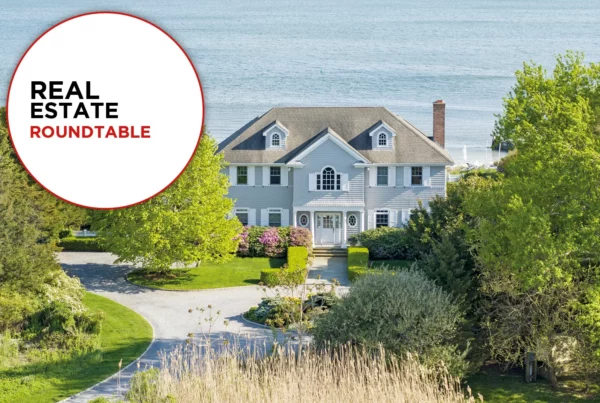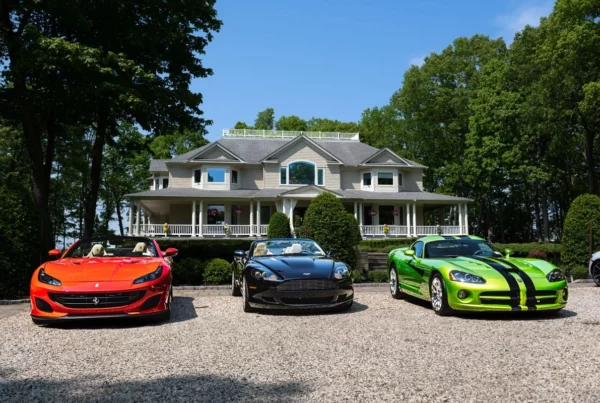The developers hope their $3M Peconic houses will start a style trend
 |
The once bright red paint on the 150-year-old barn siding is chipped and faded to silvery gray. A ghost of lettering from an old advertisement lingers. The initials, W.B., perhaps the mischievous handiwork of a 19th-century farmer’s child, are embedded in a piece of the knotty wood.
Now that the overgrown trees and brush on the surrounding former potato field have been cleared, passersby are wondering whether the weathered barnlike structure on Indian Neck Lane in Peconic is new or has stood there for centuries.
“It’s been interesting to watch people drive by and do a double take,” says Hugo Cano, standing near the front entrance of the 5,000-square-foot building, which upon closer inspection is clearly a new house, despite its salvaged barn-wood exterior.
Cano is not a farmer or historian. He’s a 30-year-old real estate developer from the Smithtown-based Three Pillars Group who, along with partners Carlo Argila, 33, and Edwin Cadamartori, 34, hopes to change the architectural landscape of theNorth Fork.
A signature style
Just as upscale locales like theHamptons, Nantucket, Mass., and Malibu, Calif., have their signature architectures, the North Fork is deserving of its own style, say these three childhood friends from the Farmingville–Holtsville area. Their vision combines barnlike exteriors that honor the area’s early agrarian traditions with the uber-modern interiors that they say their target market – urbanite second-home (and third- and fourth-) buyers – demand.
The Three Pillars Group is so certain it is on to something that it has trademarked the name “The North Fork Home,” given it a tag – “SoHo Meets NoFo” – and copyrighted designs for two houses it has just completed in Peconic.
“Rise” is the group’s name for the house on Indian Neck Lane, with its reclaimed barn siding, aged-copper weather vane and two cupolas.
Around the corner on Leslie Road is “Pure,” a minimalist-looking 5,200-square-foot barn-style structure with whitewashed vertical cedar siding, oversized buff sandstone steps and sleek metal and glass garage doors.
Each four-bedroom, six-bathroom house sits on about an acre of land and overlooks the merlot vineyards of Raphael Winery.
High-end prices
At an asking price of $3 million each, these are the most expensive inland custom houses on the North Fork, says Sheri Winter Clarry, a senior vice president at the Corcoran Group’s Southold office and exclusive listing agent for the properties.
“The exteriors are influenced by the hay barns that early English settlers built centuries ago, while the two-story interiors have an open, loftlike plan and contemporary details,” Argila explains. “Our hope is that these homes will influence and challenge other builders, from the low end to the high-end luxury market, to think out of the box in designing new homes. We’d love to kick off a new architectural trend on the North Fork.”
Jim Grathwohl, chairman of the Town of Southold Landmarks Preservation Committee and a Cutchogue resident who can trace his family’s Southold roots back to 1640, says, “From a historic preservation standpoint, we like to see new construction that meshes with the architecture and ambience of a neighborhood. Any new structure that has a facade that looks like a barn or farmhouse on the North Fork is a good thing.” Still, he adds, “My only concern is that they would look like cookie-cutter designs if too many were clustered in the same development.”
Neighbor Cindy Cichanowicz, who moved into a newly constructed 3,100-square-foot cape Colonial on Indian Neck Lane in 2000, attended a recent open house at “Pure.”
‘Simple’ but ‘gorgeous’
“It’s very simple on the outside and doesn’t look out of place with the neighboring landscape of farms and vineyards,” she says. “After seeing the inside, too, I think it’s gorgeous and will only help the value of my own home.”
James Raffel, 57, grew up on a potato farm on the North Fork and has lived in a 1950s ranch house on Leslie Road for the last 18 years. He also has noticed the new construction. “The structure looks pretty nice, but I don’t like the big white entry pillars, and I don’t like how they planted the grass into the road,” he says. “But I think this is where the North Fork is headed. People of wealth come from the city and want to take a little bit of the country back with them.”
Cadamartori says the properties will be one-of-a-kind with a number of common elements such as gated entries, metal standing-seam roofs, siding of vertical wood planks or salvaged barn wood, interior sliding barnlike doors, natural-stone or honed-limestone fireplaces, custom-designed lacquered vanities, built-in storage cubbies, and wine-tasting rooms.
Glass is a key component in the white, light-filled interior spaces. Forgoing traditional wooden balustrades, second-floor bridges that link bedrooms on both sides of the house have 42-inch-high glass sides with stainless-steel handrails. Floor-to-ceiling glass-curtain walls provide space for a home art gallery and connect the main wing of each house to a laundry-mud room and three-bay garage with private guest quarters overhead. Glass vessel sinks can be found in the bathrooms, and glass counters and Scavolini crystal-glass cabinets screen-printed with neutral colors complete the kitchen design.
An integrated iPod home audio system has a centrally located in-wall docking station in the main living area and can be heard (and volume-adjusted) in other areas of the house. “Smart home” technology gives homeowners the ability to control heat, air, lighting and security systems via mobile phones and computers.
Buffers for seclusion
Landscaping was also factored into the price of the homes, says Argila, adding that special thought was given to privacy buffers of trees. To tie in with the agrarian landscape, Jeremy Hamilton of Peconic-based Coastal Plantings and his crew combined small patches of lawn with stretches of deer-resistant native and ornamental grasses, perennials and wildflowers. Small Zen-like reflection pools complete the outdoor spaces.
The Three Pillars designers – who have built nine North Fork homes since they formed five years ago – say they will market a home only after it is done. Buyers, however, can decide whether they want a pool installed (if not, a credit will be given, Clarry says), and how to customize the closet storage system.
Two more North Fork Homes are to be built inPeconic this year, and Three Pillars is acquiring land in other North Fork communities to build six to eight more. The developers say each will be an original design, and they hope to incorporate eco-friendly features.
“The North Fork is unlike any place on Long Island, and the strong interest in luxury inland properties is no surprise and will only grow,” predicts Josh Horton, a former two-term Southold supervisor who is Corcoran’s senior managing director for the North Fork and Shelter Island.
Evans Edson, branch manager for Prudential Douglas Elliman’sSouthold office, agrees. “There is definitely a market for it. I love to see builders take into consideration the feeling and beauty of an area and build esthetically pleasing homes that don’t jump out at you.”









